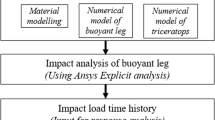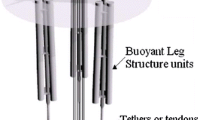Abstract
More adaptable geometric form of offshore platforms, counting on the benefits of form-dominant design, is effective to encounter various environmental loads. Offshore triceratops is a new-generation offshore platform, whose conceptual design showed good degree-of-adaptability to ultra-deep-water conditions. Deck is partially isolated from the buoyant legs by ball joints by allowing transfer of partial displacements of buoyant legs to deck but restraining transfer of rotational responses. Prior to the suitability assessment of triceratops for ultra-deep waters, detailed dynamic analysis on the preliminary geometric form is necessary as a proof of validation for design applications. Current study discusses a detailed numeric analysis of triceratops at 2400 m water depth under regular and irregular waves; preliminary design of both buoyant legs and the deck is also presented. Buoyant Legs are designed as stiffened cylinders and the deck is designed as the integrated truss system. In compliant structures, the role of tethers is of paramount importance. Hence, the stress analysis and fatigue analysis of the tethers are also carried out to assess the service life of the structure. Presented study shall aid offshore engineers and contractors to understand suitability of triceratops, in terms of design and dynamic response behaviour.













Similar content being viewed by others
References
Chandrasekaran S, Jain AK (2002) Triangular configuration tension leg platform behaviour under random sea wave loads. Ocean Eng 29(15):1895–1928
Chandrasekaran S, Jain AK (2002) Dynamic behaviour of square and triangular offshore tension leg platforms under regular wave loads. Ocean Eng 29(3):279–313
Chandrasekaran S, Jain AK, Gupta A, Srivastava A (2007) Response behaviour of triangular tension leg platforms under impact loading. Ocean Eng 34(1):45–53
Capanoglu CC, Shaver CB, Hirayama H, Sao K (2002) Comparison of model test results and analytical motion analyses for a buoyant leg structure. In: The twelfth international offshore and polar engineering conference. International society of offshore and polar engineers
Copple RW, Capanoglu CC (1995)A buoyant leg structure for the development of marginal fields in deep water. In: The fifth international offshore and polar engineering conference. International society of offshore and polar engineers
White CN, Copple RW, Capanoglu C (2005) Triceratops: an effective platform for developing oil and gas fields in deep and ultra deep water. In: The fifteenth international offshore and polar engineering conference. International society of offshore and polar engineers
Chandrasekaran S, Mayanak S (2017) Dynamic analyses of stiffened triceratops under regular waves: experimental investigations. Ships Offshore Struct 12(5):697–705
Chandrasekaran S, Sundaravadivelu R, Pannerselvam R, Madhuri S, Varthini DS (2011) Experimental investigations of offshore triceratops under regular waves. In: Proceedings 30th international conference on ocean, offshore and arctic engineering, OMAE
Shaver CB, Capanoglu CC, Serrahn CS (2001) Buoyant leg structure preliminary design, constructed cost and model test results. In: The eleventh international offshore and polar engineering conference. International Society of Offshore and Polar Engineers
Islam AS, Soeb MR, Jumaat MZ (2017) Floating spar platform as an ultra-deepwater structure in oil and gas exploration. Ships Offshore Struct 12(7):923–936
Tabeshpour MR, Golafshani AA, Seif MS (2006) Comprehensive study on the results of tension leg platform responses in random sea. J Zhejiang Univ Sci A 7(8):1305–1317
Chen Y, Zimmer RA, de Oliveira JG, Jan HY (1985) Buckling and ultimate strength of stiffened cylinders: model experiments and strength formulations. In: Offshore Technology Conference 1985 Jan 1
Chandrasekaran S, Madhuri S, Jain AK (2013) Aerodynamic response of offshore triceratops. Ships Offshore Struct 8(2):123–140
Chandrasekaran S, Nannaware M (2014) Response analyses of offshore triceratops to seismic activities. Ships Offshore Struct 9(6):633–642
Chandrasekaran S, Nassery J (2015) Springing and ringing response of offshore triceratops. In: Proceedings of the 34th international conference on ocean, offshore and arctic engineering (St. John’s, Newfoundland)
Liapis S, Bhat S, Caracostis C, Webb C, Lohr (2010). Global performance of the Perdido spar in waves, wind and current–numerical predictions and comparison with experiments. OMAE2010-2116
Veritas DN (2010) Buckling strength of shells, recommended practice DNV-RP-C202. Det. Nor. Ver. Class. AS, Veritasveien
Reddy DV, Swamidas AS (2013) Essentials of offshore structures: framed and gravity platforms. CRC Press, Boca Raton
Chandrasekaran S, Seeram M (2012) Stability studies on offshore triceratops. Int J Innov Res Dev 1(10):398–404
Chandrasekaran S, Madhuri S (2015) Dynamic response of offshore triceratops: numerical and experimental investigations. Ocean Eng 109(15):401–409
Jain AK, Chandrasekaran S (2004) Aerodynamic behaviour of offshore triangular tension leg platforms. In: The fourteenth international offshore and polar engineering conference. International Society of Offshore and Polar Engineers
DNV-RP DN (2005) C203 fatigue design of offshore steel structures. Recommended practice DNV-RPC203, p 126
Author information
Authors and Affiliations
Corresponding author
Rights and permissions
About this article
Cite this article
Chandrasekaran, S., Nagavinothini, R. Dynamic analyses and preliminary design of offshore triceratops in ultra-deep waters. Innov. Infrastruct. Solut. 3, 16 (2018). https://doi.org/10.1007/s41062-017-0124-1
Received:
Accepted:
Published:
DOI: https://doi.org/10.1007/s41062-017-0124-1




